The inkjet head is the element of a printer that applies ink onto a substrate. The inkjet head is the device integrated in printing or dispensing systems. Inkjet heads are manufactured to be either:
- Disposable: Inkjet head is bonded onto the ink cartridge (Thermal inkjet, HP, Lexmark Canon, others). Example of a disposable-type of user replaceable TIJ or thermal inkjet head.
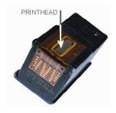
- Non-disposable: inkjet head and ink supply cartridges are separated. Piezo drop on demand, continuous inkjet. Various configurations of inkjet piezo heads:
Thermal Inkjet-Drop Formation Technology.

Thermal Inkjet/Bubblejet:
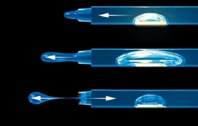 Heat creates a bubble inside the ink chamber, displacing the ink and ejecting a droplet
Heat creates a bubble inside the ink chamber, displacing the ink and ejecting a droplet - Replaceable heads
- Limited variety of liquids
- Aqueous based inks
- Dyes
- Pigments
- Heating effect causes head failure
- Made to be replaced
Piezo Inkjet Industrial Printing - Drop on Demand. More robust printing heads can be user replaced depending on the manufacturer.
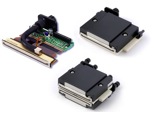
- Weak and stronger solvent based inks
- Textile dyes of various chemistries
- Dye Sublimation
- UV cured digital inks
- Compatible liquids
Sequence of an Ink Jet Firing Cycle
Voltage applied
A voltage is applied to piezoelectric element or "transducer". This causes the piezoelectric ceramic material to shorten which draws back the "piston" or "foot" at the firing chamber. Transducer movement is measured in millionths of an inch.
Piezo contracts
This, in turn, pulls ink into the chamber from the ink manifold through the restrictor. The properties of the ink are such that the surface tension at the orifices prevents air from being pulled into the chamber during this phase of the firing cycle.
Voltage released
The voltage is then released, the piezo transducer expands to its original length expelling ink out of the orifices of the chamber.
Ink fired
After the ink droplets leave the firing chamber, the fluid stabilizes and chamber readies for another firing cycle.
Continuous Inkjet
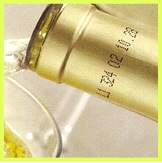
- High speed/frequency
- Marking/Coding/Expiration
- Long throw
- Can use volatile inks
- Resists clogging
CIJ Disadvantages:
- Low viscosity only
- Complex
The ink jet comes out of the printhead through a nozzle. An ultrasonic signal of a fixed frequency is generated and breaks the ink jet into tiny drops. Individual drops of ink are electronically controlled to the correct positions. Ink not directed to the media is redirected to a gutter system that returns the ink to a waste ink capture area.
MEMS Head Technology
Some years ago, many companies started to research ways of manufacturing inkjet heads using the same processes that are currently used for integrated-circuit production. This process is known as MEMS Fabrication Techniques.
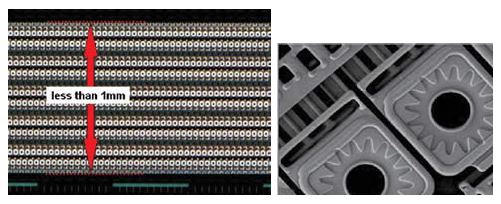
Micro-Electro Mechanical Systems (MEMS) is the technology of the very small, and merges at the nanoscale into “Nano-Electro Mechanical Systems” (NEMS) and nanotechnology. MEMS generally range in size from a micrometer (a millionth of a meter) to a millimeter (thousandth of a meter). The scale of MEMS is such that it permits larger and denser arrays of smaller ink orifices, increasing resolution and printing speed.
At these size scales, the standard constructs of classical physics do not always hold true. Some of the other benefits of silicon MEMS fabrication techniques feature sub-micron accuracy, robust material set and the ability for high-volume manufacturing. MEMS really shine in creating nozzles, holes, manifolds and channel structures in the inkjet head design.
MEMS based label printers are currently on the market, but if there are nozzle issues, the entire print bar must be replaced. These peinters are licensed and all use the phrase "MEMJET".
Head Manufacturers
Aprion, Canon, FujiFilm (Dimatix/Spectra), Epson, Konica Minolta, Hitachi, HP, Lexmark, Jetrion, Ricoh, Samsung, Benq, Brother, Lexmark, Pixdro, Seiko, Trident, Videojet, Olympus, Toshiba, Kodak, Versamark, Xaar, and more.
Inkjet Head Variables and
Productivity
- Nozzles per head
- Nozzle droplet size
- Measured in Picoliters (One Trillionth or 10 -12 liters)
- Approx. 10 million picoliters in a drop of H20
- Smaller drops produce higher resolutions
- Large drops make better overall coverage
- Variable droplets
- Firing frequency of head, specified in Mhz (drops/second)
Variable Dot vs. Fixed Dot Printheads
Printhead manufacturers of piezo head units usually make two types of heads. The first type is known as a fixed drop or a head using a singular drop size. This drop size can vary, but is fixed by the manufacturer for a given head model. Larger droplets cover more area and are typically used to print lower resolution images for large applications. Billboards can be printed at resolution as low as 30dpi with no visual degradation.
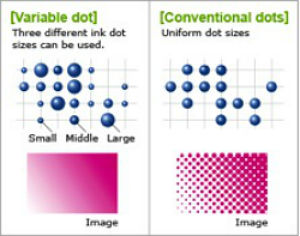 Variable drop heads, also known as Binary, or grayscale heads, have the advantage of using variable droplet sizes from the same head unit. This is accomplished by using multiple pulses or droplets that merge in flight to form a larger drop size. The merged drop is always a multiple size of the smallest droplet that the head can produce. A head with range from 6-42pl can make drops of sizes 6, 12, 18, 24, 30, 36, and 42pl. This variable dot, when accompanied by a tuned RIP can make near photographic quality images.
Variable drop heads, also known as Binary, or grayscale heads, have the advantage of using variable droplet sizes from the same head unit. This is accomplished by using multiple pulses or droplets that merge in flight to form a larger drop size. The merged drop is always a multiple size of the smallest droplet that the head can produce. A head with range from 6-42pl can make drops of sizes 6, 12, 18, 24, 30, 36, and 42pl. This variable dot, when accompanied by a tuned RIP can make near photographic quality images.
Variable sizes of dots offer better gradations with low-resolution printing. Higher resolutions become even smoother in appearance. Large dots fill in large areas quickly, small dots take longer to print.
Trends in Inkjet Head Development- Smaller dropsizes
- Variable droplets
- Smaller feature sizes
- Increasing quality
- Increasing number of nozzles
- Per head
- Per unit area
- Increasing speed
- Per nozzle
- DOD jetting frequency
- More nozzles per head
- Wider range of ‘inks’
- Printhead ‘arrays’
- Assemblies, integration of multiple heads
- Stationary heads, ‘one pass’
Scalable Head Concepts-Arrays to Single Pass
HP Edgeline Printhead Array
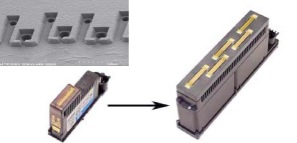
Head technology from the Photosmart Pro B9180 was used to manufacture an array of 5 heads in one unified head block. The HP Edgeline array head can print a swath of 4.25” wide and contains 10,560 nozzles (2,112 nozzles x 5)
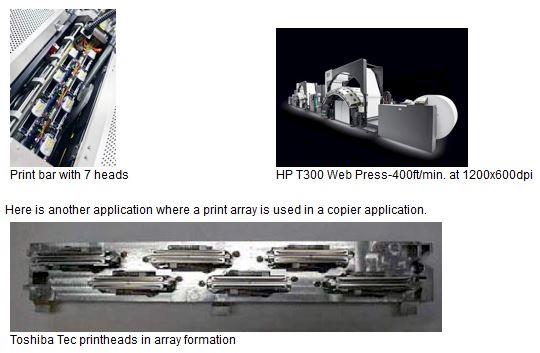
Eight of these printbars are used, one array for each color, 4 on one side and 4 on the other side for one pass duplex printing in inkjet copier by RISO (HC5000).
Inca Onset
Go with a massive head array printer. Inca Digital has built the Inca Onset. Carrying a staggering array of 576 Spectra print heads and addressing a total of 73,728 inkjet nozzles, the printer boats a print speed of 500 sq. meters per hour. The heads are situated in “plug-in print bars”, utilizing an innovative alignment system. Beta testing is currently in progress, with an estimated price tag of $3 million, (don’t quote me on this one).
Truepress Jet520
Dainippon Screen has incorporated Epson DOD piezo heads into a web fed press that runs up to a maximum rate of 210 ft. per minute. This uses water based inks, running roll stock with a maximum paper width of 20.4” inches.
That’s 420 full-color letter sized pages per minute. You can tie two of these devices together for full duplexing capabilities. The workflow uses JDF-based job tickets as well as other standard file formats.
Agfa Dotrix
This web fed, UV curable, single pass inkjet has a maximum printing width of 24.8” inches. Running at speeds of between 17-78 ft/min., capable of 300 dpi resolution.
Agfa Transcolor
This newer UV inkjet model has been developed for transactional printing using variable data. It incorporates dual printing units, capable of producing 2-sided documents at rates up to 484 pages per minute. Maximum print width is 17.92” with extremely fast impressions per minute numbers varying with the particular configuration set.
Kodak Versamark
Kodak is still one of the leaders in inkjet printing speed for transactional print jobs. The Versamark series is a modular one, where heads can be added to make up any type of ink scenario necessary. Black only, black with spot, add 4 color process, add duplexing if need be. Resolution ranges from 300 x 300, 300 x 600 or 300 x 1200.
Unanswered Questions
Over the last twenty years, printers have become well-acquainted with the idea that they must adopt new technology to survive. For some time now, inkjet has held out the promise of huge business benefits over conventional print processes. The improvements to conventional offset – with emphasis on unit-cost reduction through multi-unit sheet fed and high-pagination web, together with high levels of automation – have boosted productivity but have not expanded the functionality of print in the way that digital can, with its ability to personalize or create versioned print runs.